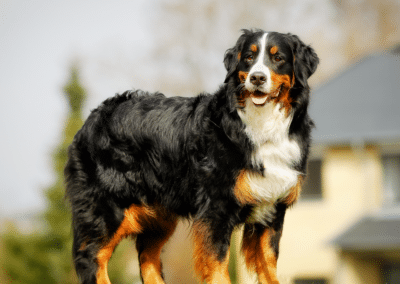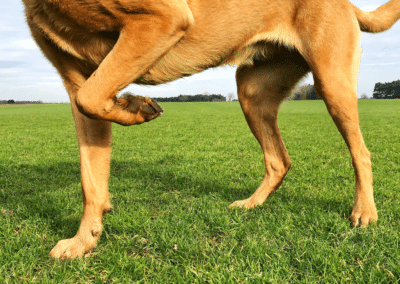Arthritis in dogs, commonly known as osteoarthritis or degenerative joint disease, is the most common health problem and can affect all breeds. In total, it is estimated that over 14 million pets in the U.S. have arthritis and, unfortunately, only a small percentage of these animals are receiving treatment.

Arthritis is an inflammatory response to joint trauma or disease that causes further damage to the connective tissue and cartilage in joints. Inflammation continues and progresses to a debilitating condition that can severely affect joint mobility and health.
Causes of Arthritis in Dogs
Arthritis in middle-aged or older dogs often develops because of an earlier, often seemingly minor trauma – even the smallest of injuries where limping or soreness of a joint is present should be checked by your veterinarian. Some causes can include:
- Infection in a joint
- Dislocation
- Trauma
- Hip dysplasia
- Immune system problems
- Stress on joints caused by excess weight
- Ligament, tendon, or muscle injury
- Aging and natural erosion of cartilage
Symptoms of Arthritis in Dogs
Joints are living structures that are capable of repair, but as a dog ages, this repair process becomes less and less successful. Years of repeated movement cause the joint capsule and the ligaments to begin to stretch, allowing the bones more space than usual to move which can bruise and erode the joint surfaces causing inflammation. As these surfaces continue to move, the inflammation causes new bone to grow where it shouldn’t and bone to be reabsorbed from where it is critically needed.
Visible symptoms of arthritis can include:
- Loss of mobility and flexibility
- Walking stiffly
- Discomfort and difficulty laying down or getting up
- Inflammation of joints
- Atrophy of surrounding muscles
- Hesitancy to jump, run, or climb stairs
- Favoring a limb
- Weight gain
- Decreased activity or interest in play
- Quickly withdrawing a limb if touched
- Growing or snapping when a limb or joint is manipulated
The Osteoarthritis Process

Initiation Phase – Aging, stress, or an injury produces wear and tear on the joint cartilage. The body reacts by secreting pro-inflammatory cytokines and adhesion molecules and the inflammation builds until the threshold is met.
Inflammatory Phase – When the inflammation threshold is reached the immune system sends killer T-cells to the site. These cells activate the production of collagen-specific antibodies from B-cells and these antibodies migrate to bind to the joint cartilage.
Destructive Phase – Antibody-tagged cartilage is targeted by macrophages which release a powerful enzyme called collagenase that breaks down collagen.
Debilitating Phase – Continued exercise or movement within the damaged joint causes a cyclic acceleration of the inflammatory phase resulting in increased pain, loss of mobility and flexibility, and further erosion of joint cartilage which can lead to atrophy of surrounding muscles and the weakening of supporting ligaments and tendons.
Diagnosis of Arthritis in Dogs
Along with checking your dog’s medical history for previous injuries and taking x-rays, your veterinarian will perform a physical examination of your dog which is designed to elicit subtle signs of pain during walking or over-flexing the joints. An osteoarthritic joint will produce pain, swelling, and erosion of the cartilage, loss of lubrication, decreased flexibility and mobility along with atrophy of the surrounding muscles, ligaments, and tendons.
Treatment of Arthritis in Dogs
Once arthritis sets in, there is really no viable cure. It is important for you to work with your veterinarian to create a program to minimize your dog’s pain while keeping them as healthy and mobile as possible.
Some general treatment options may include:
- The use of antibiotics, pain killers, or anti-inflammatory medications
- The use of nutritional supplements designed to help replenish cartilage
- Providing a healthy diet and regular, low-impact exercise
Supporting Joint Health

Exercise – When faced with joint disease, exercise should be limited to leash walking, swimming, and other low-impact exercises until the joint becomes stabilized and muscle atrophy is reversed.
Weight Control – Maintaining normal body weight in dogs is the most proactive thing you can do to help prevent or manage osteoarthritis. Weight loss is a matter of balancing the number of calories going in with the amount being expended. Safe and effective weight loss can be accomplished by reducing a dog’s regular diet by 25% and replacing the lost nutrients with a supplement.
Steroid Treatment – This may be effective in relieving pain and discomfort at first, but it is not a safe and effective long-term strategy
Prevention – Proactive supplementation of specific joint health ingredients in large breed dogs, athletic animals, and those breeds having a high incidence of hip dysplasia is also highly recommended. If you use a choke collar or common neck style leash instead of a harness, cervical damage can result from dogs that pull, leap, or jerk against the collar or owners that believe jerking back on the collar is a good way to correct poor behaviors while walking.

This material is provided for educational purposes only and is not intended to diagnose or treat any disease or condition. All specific treatment decisions must be made by you and your local, attending veterinarian.









0 Comments